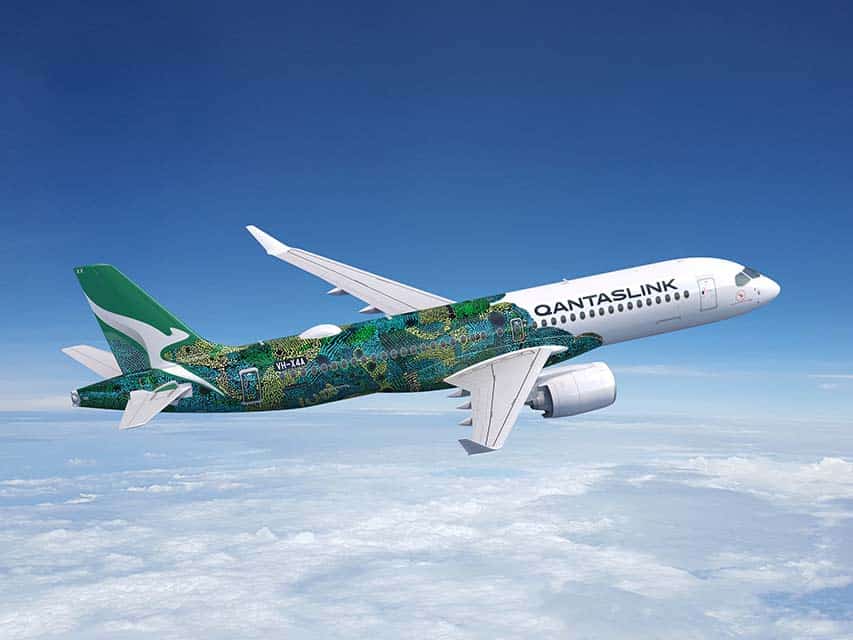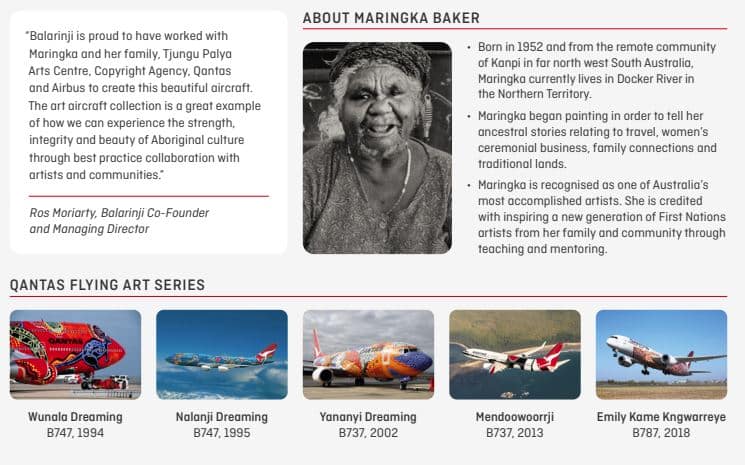Aerospace
The Story Behind QantasLink’s A220 Artwork ‘Minyma Kutjara Tjukurpa’
QantasLink’s Cultural Soar: Unveiling the Artistry of ‘Minyma Kutjara Tjukurpa’ on the A220

Every nation holds a unique tapestry of traditions passed down from ancestors, woven into the fabric of their living culture, and preserved through various mediums, such as paintings. Australia, too, boasts a rich cultural heritage and traditions, prominently displayed in entities like Qantas Airlines.
The airline consistently reflects the roots from which the country springs. Just yesterday, they unveiled a new A220 aircraft adorned with a distinctive painting, offering insight into the selection process for this artwork.
QantasLink recently revealed its inaugural Airbus A220 aircraft, fresh from the paint shop at Airbus’ facility in Mirabel, Canada. This marks a significant milestone in the Qantas Group’s initiative to renew its fleet. This particular aircraft, the first of 29 A220s slated for delivery as part of the domestic fleet renewal program, is scheduled to arrive in Australia by year-end.
Minyma Kutjara Tjukurpa Painting story.
A notable feature of this Qantas A220 aircraft is its unique painting titled ‘Minyma Kutjara Tjukurpa,’ the sixth installment in the Qantas-Balarinji Flying Art series. The artwork narrates the dream story of two sisters embarking on a journey back to their homeland.
The younger sister, lost in the south for an extended period, is guided north by her elder sister across vast landscapes. Along the way, the elder sister imparts knowledge about the land they traverse, and they pause to engage in Inma, a sacred ritual involving singing and dancing.

Initiated in 1995, the Flying Art Series has showcased six remarkable Aboriginal artworks across Qantas’ fleet. The renowned First Nation design agency, Balarinji, collaborated with Aboriginal artists and their representatives to develop these artworks.
The livery for ‘Minyma Kutjara Tjukurpa’ was specifically designed by Balarinji, and the aircraft (registration: VH-X4A) was meticulously painted by Airbus in Mirabel, Canada, a process taking over two weeks.
Approximately 100 painters, utilizing 130 stencils
The intricate design, featuring more than 20,000 dots, represents the most complex livery Airbus has ever undertaken for this aircraft type. Approximately 100 painters, utilizing 130 stencils, were involved in replicating the detailed Aboriginal designs.
Maringka Baker, a senior Pitjantjatjara artist from the remote community of Kanpi in far north-west South Australia, is the creative force behind ‘Minyma Kutjara Tjukurpa.’ Her artwork focuses on ancestral stories related to travel, women’s ceremonial practices, family ties, and traditional lands.
Recognized as one of Australia’s most accomplished artists, Maringka has played a pivotal role in inspiring a new generation of First Nations artists from her family and community through teaching and mentoring.
QantasLink A220 is configured with 137 seats
Following its painting in Canada, the aircraft will journey from Quebec to Australia, joining the QantasLink fleet. Its initial routes will connect Melbourne and Canberra. Six more A220s are slated for delivery by mid-2025.
The QantasLink A220 is configured with 137 seats in a two-cabin layout, comprising 10 Business seats and 127 Economy seats. These A220s are strategically positioned to connect smaller capital cities like Canberra and Hobart with major hubs in Brisbane, Melbourne, and Sydney.

Aerospace
Boeing Transfers Rocket Stage to NASA, Paving Way for Human Moon Mission

Boeing has achieved a significant milestone by providing NASA with the second core stage of the Space Launch System (SLS) rocket.
This crucial component, crafted at NASA’s Michoud Assembly Facility (MAF), is set to propel the Artemis II crew into lunar orbit, marking humanity’s return to deep space after a 50-year hiatus.
The monumental Boeing-built rocket stage, the largest element of the Artemis II mission, will embark on a journey aboard the Pegasus barge, traveling 900 miles to NASA’s Kennedy Space Center.
Comparison of two legendary aircraft B777x vs B747 aircraft:Click here
Upon arrival, it will be meticulously integrated with other essential Artemis II components, including the upper stage, solid rocket boosters, and NASA’s Orion spacecraft within the iconic Vehicle Assembly Building. This intricate integration process is a vital step toward the eagerly anticipated Artemis II launch, slated for 2025.
“Boeing-built products helped land humankind on the moon in 1969, and we’re proud to continue that legacy through the Artemis generation,” remarked Dave Dutcher, vice president and program manager for Boeing’s SLS program. “Together, with NASA and our industry partners and suppliers, we are building the world’s most capable rocket and paving the way to deep space through America’s rocket factory in New Orleans.”
NASA, Lockheed Martin Reveal X-59 Quiet Supersonic Aircraft:Click here
The delivery of Core Stage 2 marks a significant achievement in the evolution of the SLS rocket. Towering over 200 feet and powered by four RS-25 engines, this core stage, coupled with two solid-fueled booster rockets, will generate a staggering 8.8 million pounds of thrust. This immense power is crucial to launching Artemis II and future missions into the vast expanse of space.
The SLS rocket stands unparalleled in its capability to transport both crew and substantial cargo to the moon and beyond in a single launch. Its extraordinary capacity will facilitate the delivery of human-rated spacecraft, habitats, and scientific missions to destinations including the moon and Mars, ushering in a new era of space exploration.
-

 Travel1 week ago
Travel1 week agoAir India to Expand US Operations with Three New Routes After a Decade
-

 Travel2 weeks ago
Travel2 weeks agoWhy We Should Avoid These Stamps in a Passport
-

 Airlines1 month ago
Airlines1 month agoInvestigations Reveal Fake Chinese Titanium in Boeing and Airbus Jets
-

 Tech4 weeks ago
Tech4 weeks agoChina’s CATL Plans 1,800-Mile Electric Plane Launch by 2027
-

 Airport3 days ago
Airport3 days agoTop 10 Largest Airports in the World by Size
-

 Aerospace4 weeks ago
Aerospace4 weeks agoChina’s Fighter Jets Turn Wings into Autonomous Drones
-

 Airlines4 days ago
Airlines4 days agoAir India Rolls Out A350s for Delhi-New York JFK and Newark Routes
-

 Defence3 weeks ago
Defence3 weeks agoBoeing Enhances Chinook with New Engines and Block II Upgrades at $96 Million







